Cash Access Remains a Consumer's Indisputable Option in Commercial Transactions
In the archipelago nation of the Philippines, the shift towards digital finance is underway, but not without its challenges. According to recent data, around 16.2% of Filipinos do not have access to e-wallets or online banking due to internet access issues, highlighting a digital divide that persists within the country.
The Philippines, with its more than 7,000 islands and hundreds of municipalities still lacking physical bank presence, faces unique challenges in embracing digital finance. Internet access remains expensive and patchy compared to regional peers, making digital payments inaccessible for many, particularly those in rural areas.
However, the country has all the rights to embrace digital finance. The Bangko Sentral ng Pilipinas (BSP) is driving this shift with programs like Paleng-QR PH, QRPh standards, and cashless transport systems. In fact, more than half of retail transactions in the Philippines are already digital. GCash and Maya have become daily tools for millions, particularly in cities, with GCash recently rolling out "tap-to-pay" technology.
Yet, progress must not come at the cost of exclusion or fragility. Cash is not the enemy, forcing people into a corner where they cannot pay is. For many rural Filipinos, cash may be the only viable option. The New Central Bank Act and the Civil Code both make it clear that cash cannot be refused for goods and services.
Cashless-only policies are troubling as they exclude those who cannot or do not use digital payments. This issue has been raised by consumer advocacy groups like the Philippine Consumers Protection Foundation and government agencies such as the Department of Trade and Industry. Advocates are pressing the issue with regulators, calling for clear rules that protect consumers.
Inclusion should mean everyone is part of the system, not only those who already have the tools for digital payments. The debate about the risks of leaving people behind with digital payments is resurfacing in the Philippines. A hybrid model that keeps both cash and digital channels open maximizes reach, avoids alienating cash users, and ensures no one is turned away.
Moreover, cash could be the only reliable medium during disasters when power lines fall and networks fail. The Philippines, prone to natural calamities, needs to consider this aspect carefully.
Russel Stanley Geronimo, a lawyer and CEO of Geronimo Law, has been vocal about denying consumers the use of cash. However, his stance has sparked concern among those who advocate for consumer rights and financial inclusion.
In a country with the highest percentage of unbanked and underbanked people compared to other Southeast Asian countries like Indonesia, Vietnam, and Thailand, the need for inclusive financial systems is paramount. Around 34 to 37 million Filipinos remain unbanked, which is about four in ten adults. When underbanked Filipinos are considered, about 76% of the total population is not fully served by the banking system.
As the Philippines navigates its digital finance journey, striking a balance between progress and inclusion will be key. Ensuring that all Filipinos, regardless of their location or digital literacy, have access to financial services will be crucial in building a truly inclusive digital economy.
Read also:
- Peptide YY (PYY): Exploring its Role in Appetite Suppression, Intestinal Health, and Cognitive Links
- Toddler Health: Rotavirus Signs, Origins, and Potential Complications
- Digestive issues and heart discomfort: Root causes and associated health conditions
- House Infernos: Deadly Hazards Surpassing the Flames








